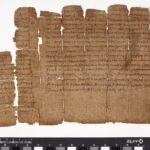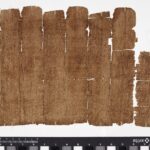| Artefact ID | 508 |
| TM ID | TM 62826 |
| Findspot (DEChriM ID) | - () | Class | Textual |
| Material | Papyrus |
| Writing medium | Sheet/roll |
| Text content | Documentary, Literary |
| Language | Greek |
| Description | P.Ryl. III 469; KV89 Papyrus fragment containing Theonas (uncertain) letter against the Manicheans. The text is comprised of 2 fragments (the largest measuring 19.5 x 35.7 cm) from a papyrus roll. The fragments preserve two large columns of text, and the verso remains blank. The papyrus is of a double thickness, and there are 9 folding-lines visible in a regular interval, which is suggestive of a folded letter format, but no part of the address survives. The letter could be perceived as both an official document as well as a literary composition, as it is an actual letter addressed and sent to a recipient, but with clear, literary value; see ed. pr. The text appears to be a letter sent from the chancellery of a bishop of Alexandria, probably Theonas (his episcopate lasted from 282 to 300 CE), addressed to the churches within his diocese. His intent is to repel the Christians from the Manichean religion and especially from the female cult-members who apparently were going door to door professing the Manichean doctrines. The text bears special affinities to the letters of Paul, as is seen in the many insertions of Pauline quotes; see ed. pr. The ed. pr. notes that the text is the oldest anti-Manichean document currently known, and that its form is closely related to the Formula of Abjuration, which the converted Manichaeans had to recite before being admitted into the Church. The hand is not a book hand: it is official, regular and cursive. The text contains corrections made by a second hand (lighter ink, see l. 16), and has clear punctuation and breathings produced by the first hand. There are several nomina sacra. |
| Selection criteria | Literary genre (Theological), Christian terms/formulas/concepts, Nomina sacra |
| Date from | 250 |
| Date to | 399 |
| Dating criteria | Palaeography and historical considerations. Dated to the late 3rd c. by the ed. pr. (giving the comparanda of P.Flor. II 254, a private letter from 259 CE, Theadelphia), who does not exclude a possibility of a date in the early 4th c. The date in the late 3rd c. is further supported by the edict of Diocletian in 296 CE, which ordered a general persecution of the Manicheans. |
| Absolute/relative date | Relative date |
| Archaeological context | Provenance unknown. |
| Accession number | Manchester, John Rylands Library, Gr. 469. |


 Json data
Json data





